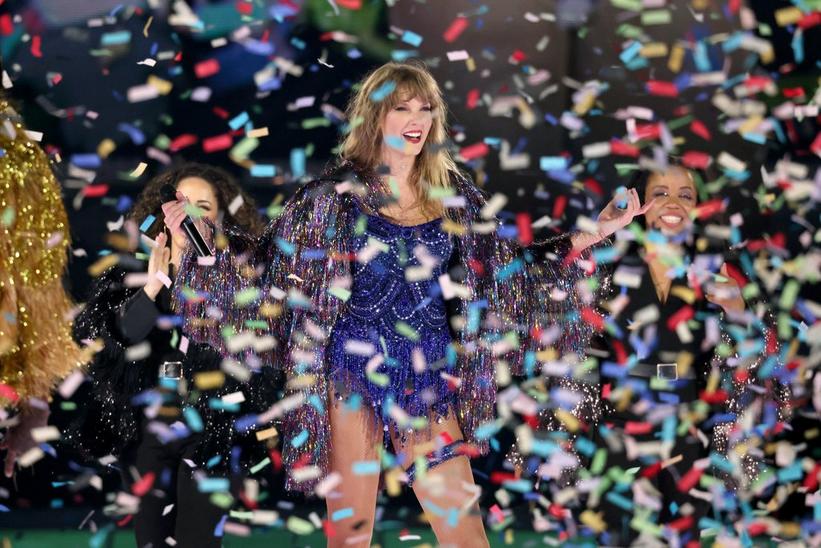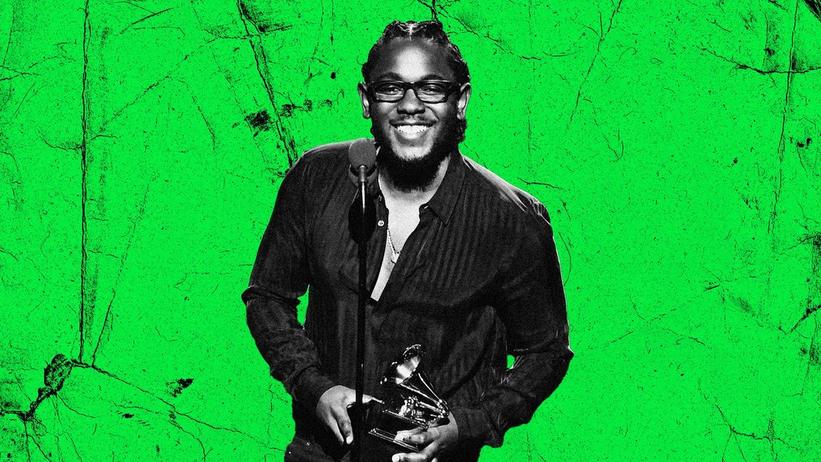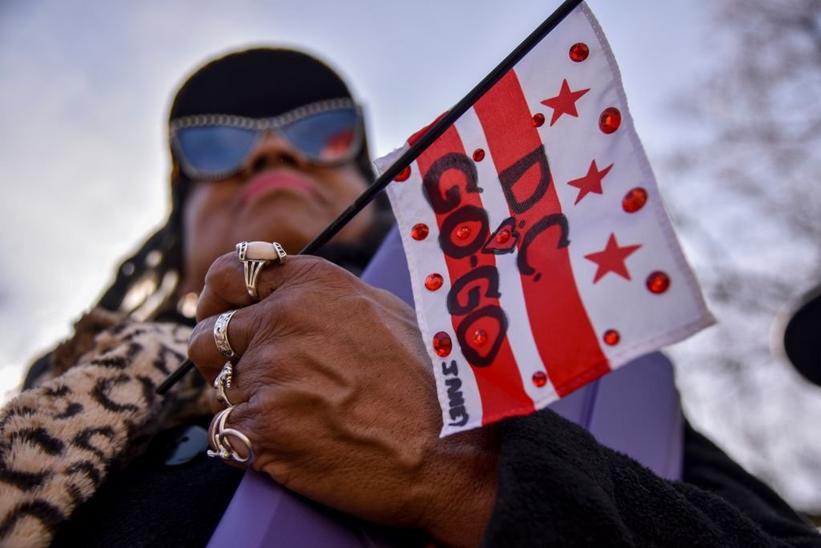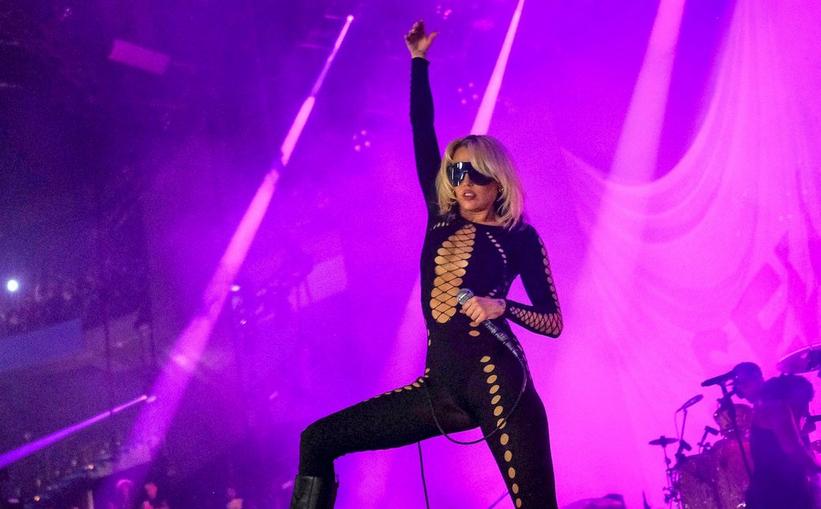When hip-hop began to emerge in Washington, D.C. and the surrounding areas of Maryland and Virginia, every song, album, and artist had a go-go reference. Read on for a history of the genre and how it influenced the many sounds of DMV hip-hop.
In 1987, Salt-N-Pepa's "My Mic Sounds Nice" became an instant favorite in clubs and radio stations across America. Built around a sample of Grover Washington Jr.'s "Mister Magic," the go-go beats were a clear call to the other place producer Hurby "Luv" Bug the song’s producer, was a clear call – down I-95 in Washington, D.C.
Salt-N-Pepa weren't the only New York City based hip-hop act to incorporate go-go beats. In fact, the majority of club and radio friendly songs of the 1980s had some linkage to D.C.'s homegrown sound. Yet down in the capital city, D.C. clubs largely favored go-go over the emerging sounds of hip-hop — and that dissonance would give rise to a unique sonic palette in the city.
When hip-hop began to emerge in the DMV — the district. D.C. and the surrounding areas of Maryland and Virginia — every song, album, and artist had a go-go reference. As a result, DMV hip-hop had a unique musical center that differentiated it from hip-hop from other regions. The future of hip-hop in the DMV would be inextricably linked to go-go for the rest of time.
Bustin' Loose: Creating The D.C. Sound Of Go-Go
Before hip-hop, there was go-go. Known for its high-spirited live instrumentation and boisterous call and response, the post-funk, percussion-heavy music was born in the Black neighborhoods of a then-majority Black Washington, D.C. in the early to late 1970s. Heralded by young people, who created and innovated on the genre, the sound evolved into a movement.
Despite sharing a similar origin story to hip-hop, go-go was always the preferred sound of D.C. Go-go’s history predates that of hip-hop music by nearly 10 years.
By 1965, go-go’s self-professed godfather, Chuck Brown, fused what he had learned as a supporting guitarist for soul artists including Jerry Butler, and joined the Los Latinos band in 1965
Because of that band – and others – playful melodies, percussion and interactive performances, go-go spread throughout the city and its surrounding suburbs. Go-go became the voice of Chocolate City, a name given to the District of Columbia because of its abundance of Black residents.
Similar to many genres born from the call and response tradition, go-go needed a bandleader or, in its case, "a talker." And Chuck Brown emerged as the one to take the culture forward.
Brown, affectionately known as the Godfather of Go-Go, became the face of the genre. While a member of the band Los Latinos, Brown developed an awareness and love of the Latin percussion groves, prominent in the band’s repertoire. His incorporation of those grooves, along with James Brown influence, and African-inspired drum patterns combobulated into a distinctive sound. As the band would play, Brown would break the song down through segmented patches of percussion and call response, over time, this would become known as his signature.
Over time, the band’s name changed from Los Latinos to the Soul Searchers, signed to a national label and released their debut album, We The People, in 1972. The album’s title track ushered in a series of hits followed by "Blow Your Whistle" on their sophomore album Salt of the Earth, and "Bustin' Loose," a gold-charting 1979 single, which became a go-go classic. Alongside Experience United (E.U.), Rare Essence and Trouble Funk, the band laid the foundation for go-go’s success in the hip-hop age.
As hip-hop developed in the 1980s, Junkyard Band, a go-go band composed of Black youth, started to gain success on a local and national level. The group was featured in two films: 1983’s D.C. Cab and 1988’s Tougher Than Film. The latter film, directed by music producer Rick Rubin and starring Run D.M.C., was not the first time a Simmons has been involved with the go-go scene.
Fascination with go-go only grew, drawing interest beyond the DMV. Between 1983 and 1984, record executive Russell Simmons and artist Russell Simmons hired E.U. to play drums on two releases: "Party Time" by Kurtis Blow and "Slave to the Rhythm" by Grace Jones. In 1984, Chuck Brown & the Soul Searchers released "We Need Some Money," one of the first records to be described as Brown rapping. Two years later, Junkyard Band signed to Simmons and Rubin's Def Jam Recordings and released their debut LP, The Word/Sardines. Rubin, a penchant for the region’s sound, used the drums from "Drop the Bomb," the title track from Trouble Funk’s 1982 album on the Beastie Boys' 1986 debut, Licensed to Ill.
Rubin and Simmons were not the only ones interested in go-go. Spike Lee was exposed to go-go at the 9:30 Club. His first exposure, the reaction of Howard University students to EU’s performance of "Da Butt," resulted in the director hiring the band to produce a song for the soundtrack of his next film School Daze. The 1988 single achieved success on the pop and R&B Billboard charts.
Hip-Hop Begins To Show Up In D.C.
As the decade progressed, hip-hop and go-go continued to interact with each other, but their paths remained separate and parallel. Hip-hop was described as "bamma. Uncultured, uncool, some New York s—," by D.C. residents.
"Stone Cold Hustler" — the 1987 debut single from rapper D.C. Scorpio — was the first attempt at a combination of hip-hop and go-go. and changed perceptions about hip-hop in the region.
In 1988, D.C. Scorpio battled then-burgeoning local rapper Fat Rodney at Marty’s Chapter III, a music venue in Southeast D.C. (A further sign of hip-hop and go-go integration, Rodney also performed alongside popular go-go acts Rare Essence and Junkyard Bard at local venues.)
The duo represented two sides of the region’s burgeoning rap scene: Scorpio backed by a record label, Rodney backed by the streets.
"Bustin Out," Rodney's posthumous 1989 release, was the second attempt at the incorporation of hip-hop and go-go. Ultimately, the song succeeded at pushing D.C. hip-hop forward.
However, as D.C.’s national hip-hop standing rose, its national profile was severely hindered.
The record breaking number of homicides in D.C. resulted in a new classification for Chocolate City: murder capital. Then-Mayor Marion Barry was arrested in an FBI sting operation; the city became known as an "important node" in the drug transportation network along the East Coast.
Music followed suit. Shortly after Rodney’s death in 1989, Rare Essence oriented themselves towards predominant R&B sound. Junkyard Band took a hiatus from music. EU also adopted a heavy R&B sound.
Local Universities And Scenes Push Hip-Hop Forward
While some of the biggest names in go-go and hip-hop experienced a personality crisis, the seeds planted by early hip-hop adopters took root at D.C.'s many universities.
"Dusk till Dawn," a student radio show at the University of Maryland, featured music from local rappers. Asheru and Blue Black convened on the grounds of University of Virginia, eventually resulting in the formation of the Unspoken Heard collective, and later Seven Heads Entertainment. The campuses of Virginia State and Virginia Union universities served as the feeding groups for the Boogiemonsters, a hip-hop group composed of Mondo McCann, Vex Da Vortex, Myntric, and Yodared.
A few musicians from the go-go scene achieved some success at this time. In 1991, Stinky Dink released "One Track Mind" on Luke Records, a Miami-based record label started by Dr. Luke of 2 Live Crew. Sam The Beast, a rapper from Charlottesville, Virginia released "Knock Some Boots'' on Atlantic Records in the same year.
A hip-hop movement was also growing along the U Street Corridor. Venues like the Station of the Union bar in North West D.C., Kaffa House and Bar Nun became incubator spaces for emerging rappers.
Opus Akoben, a three member group composed of Kokyai, Sub Z, and Black Indian came into being in 1994; Kokyai and Sub-Z knew of each other through their involvement in the burgeoning hip-hop scene of the U Street Corridor. Black Indian, then a teenager, joined the group on an European tour, where they were well received.
The three rappers were also involved in Freestyle Union, a cypher workshop hosted by hip-hop activist, educator and fellow emcee Toni Blackman and Monty Taft at the area's 9:30 Club. Founded in 1994, Freestyle Union was a creative space for emcees interested in the art of lyricism, activism, and storytelling.
For as much as conscious hip-hop was a cultural movement in D.C. and elsewhere, the city’s history with party-friendly and go-go inspired rap records was not entirely forgotten.
"The Water Dance," a 1994 single from DJ Flexx encapsulated that youthful spirit. The song quickly spread throughout the D.C. area, stretching outside the Mid-Atlantic to Atlanta and Philadelphia. Two years later, D.C. had another party anthem with DJ Kool’s "Let Me Clear My Throat" (its title taken from a line on Licensed to Ill), which topped dance charts in the United States and abroad.
DJ Kool was not the only D.C. area musician with a hit on the Billboard charts. Nonchalant, a rapper affiliated with the city’s open mic scenes found success with "5 O’Clock," a 1996 single from her debut album Until the Day, that charted on the Hot 100, R&B/Hip-Hop, and dance charts. The single was an amalgamation of producers from the scene along with production from DJ Young Guru, a regular of the scene and student at Howard University.
Silence Falls On The District As Major Labels Look Away
In the new millennium, hip-hop had begun its ascent into broader pop culture. And, finally, had begun to find its footholding in Chocolate City.
D.C. youth were determined to be heard on a national and international stage. And the labels were eager too. Union Records signed 3LG, a socially conscious hip-hop group. RCA Records signed Questionmark Asylum, a four member group. The Album, their debut release, was highly acclaimed with "Hey Lookaway" and "Get With You" as stand outs.
On the more aggressively criminalized front, by 1998, Tommy Boy Records signed Section 8 Mob, a D.C. hip-hop group founded in 1992 under the name Section.
By the spring of 2000, both movements were gaining steam.
Black Indian — a favorite of both conscious and street rappers — released Get 'Em Psyched!!, his debut album on MCA Records. Eventual U Street area legends Asheru & Blue Black's Soon Come was released in 2001 and was heralded as an underground hip-hop classic.
Small and independent record labels were cognizant of movements borne by day in many of the city’s hotbeds of rising crime and by night in the city’s opulent downtown nightclubs – oftentimes rivaling those in other rap capitals of the era.
Of note, Storm The Unpredictable, a local rapper who received a distribution deal with H2Pro/Orpheus/EMI, earned positive response for his 2003 album Amalgamation, but at that time, major record labels had shifted their interests towards burgeoning rap scenes in Atlanta, Houston, Memphis and more.
A New Wave Of Hip-Hop In D.C.
It wasn’t until the blog era of the mid-to late 2000s — an unprecedented period of online music discovery and exploration —that rappers from D.C. received another look from major record labels.
A return to the collegiate, intellectual vibe of the U Street corridor in the 1990s highlighted the era. The era’s hipster aesthetics placed D.C, rapper Wale in conversation with rappers from around the country. His 2006 release "Dig Dug," made in remembrance of Ronald "Dig Dug" Dixon, the lead percussionist of go-go group Northeast Grooves, was an auditory emblem of hometown pride and an early indicator of how he would incorporate go-go into hip-hop.
The success of "Dig Dug" began to change perceptions of D.C. as a hip-hop town, not a go-go town that engages in hip-hop. Local radio stations were bombarded with requests to play "Dig Dug" and Wale later received the D. C. Metro Breakthrough Artist of the Year Award at WKYS's Go-Go Awards.
At the top of the year, producer Mark Ronson hired Wale for his UK tour and placed Wale on a remix on Lily Allen’s "Smile." Ronson later brokered a production deal for the artist with his company Allido Records, produced Wale's 100 Miles & Running mixtape , and performed alongside him at the MTV Video Music Awards in 2007.The true pinnacle of his success was his 2008 deal with Interscope Records, which was the result of a war between Def Jam, Atlantic Records, and Epic Records. Wale was now the face of D.C. hip-hop.
Wale was not the only artist garnering attention for his musical innovations. Tabi Bonney, a D.C. native, received video play for "The Pocket," his debut single. Born in Togo, but raised in the District, his contribution to the local hip-hop scene was the introduction of Afro-funk elements, inspired by his father Itadi Bonney.
His presence opened go-go, a cultural production of Black D.C., to a global Black audience and brought another dimension to the regional sound. Like Wale, Bonney tapped the local and growing hip-hop culture to create music that felt truly like himself. "On Jupiter," a track from The Summer Years, a 2011 mixtapes, places him not only in conversation with his father’s musical legacy but his own.
In the early aughts, the U Street corridor continued to serve as an incubator for the region’s artists and musicians. Spaces like the Up and Up, an open mic that started at Bowie State University, but found a home at Liv Nightclub in D.C. became a third space for artists like Gods’illa. The Diamond District, a three person rap collective of XO, yU the 78er, and Oddisee appeared on the scene with "Streets Won’t Let Me Chill," and In The Ruff, their 2009 debut album.
With the increased visibility of the media and savviness of Internet culture, artists of this era were marketed as being from The DMV. An abbreviation that stands for the District, Maryland, and Virginia. The origins of the name are highly contested.
According to The Washington Post, the DMV moniker has three origin stories. The first states the moniker was created by 20 Bello, a local rapper who ran the-now defunct website DMV Underground; the second says local promoter Dre All Day in the Paint created the term in 1995, and local radio stations and DJs picked it up from him; the third story says local rap group Target Squad made the term as a sign of unity amongst the regional rap community. Regardless of which story rings true, the term like "The Dirty South '' for rappers under the Mason Dixon Line, consolidated rappers from D.C. and its surrounding areas, to be able to compete against other established hip-hop scenes.
Right before the start of the 2010s, Wale released Attention Deficit,his debut studio album. With singles such as "Chillin" with Lady Gaga, "World Tour" with Jazmine Sullivan, and "Pretty Girls" with Gucci Mane and Weensy of Backyard Band, a go-go band, Wale was on his way towards being a national success. That year, he earned a coveted position on the XXL Freshmen Class.
If 2009 was the year of hipster rap in D.C, 2010 belonged to the streets. It had been decades since the city’s underground had a visible presence in hip-hop, and the coming of Fat Trel felt like an opportune time for them to be heard. A native of Northeast D.C, Trel drew from several rap lineages: gangsta rap, battle rap, and lyricism rappers like Scarface. His witted delivery made him stand out amongst his peers.
His 2010 mixtape No Secrets netted singles "Cremate Em" and "Patron In My Cup" (which samples DJ Class’ Baltimore club hit "I’m The S—") . Produced by The Board Administration, an independent record label started by Wale and marketing executive Greg Harrison, No Secrets became one of the most popular mixtapes in the region. Further, the association aligned Wale with the renaissance of street hip-hop in the D.C. In return, Fat Trel and his group The Slutty Boyz had the backing of an up and coming star.
Born and raised in Southeast D.C., Shy Glizzy's authenticity and unabashed descriptions of the intricacies of the neighborhood made him a rapper to watch out for. He entered entered the hip-hop scene in 2011 with No Brain, and was named by Complex as "10 New DMV Rappers To Watch Out For" in 2012.
Yet it was "3Milli", a 2012 diss track towards Chief Keef, that placed him on a national stage. He also dissed Fat Trel on "Disrespect the Tech," a 2012 release which resulted in a years long beef between the two rappers.
As decade hit its midpoint, Fat Trel left The Board Administration to join Wale at Maybach Music Group, a record label imprint founded by Rick Ross. Wale left Introscope to sign with MMG in 2011. Shy Glizzy was selected to be a part of the XXL Freshmen Class for 2015. Yet it was 2014 that served as a changing of the guard for hip-hop in the DMV.
Under the noise of Wale’s success, a new crop of unconventional rappers had emerged. Logic, a biracial rapper, born tin Rockville, Maryland, had been steadily growing his profile online. When he signed to Def Jam Recordings in 2013, he had accumulated millions of views on YouTube, critically received mixtapes, and a spot on the XXL Freshmen Class of 2013. Logic represented a new generation of rappers born and raised in the DMV, who drew from external influences in their music, not local.
Another who used the Internet to avert regional perceptions was Rico Nasty. In 2016, she began to upload songs on SoundCloud and YouTube. Within months, the songs received millions of views and garnered her placements on series like "Insecure" and multiple best-of lists.
Her music, self described as "sugar trap,"is equal parts soft, vulnerable, poetic, and vengeful, aggressive, frantic, and rough, with influences from Avril Lavigne and Joan Jett. Early tracks like "Smack A Bitch" and "Poppin" indicated her expressive range as an artist. The incorporation of alter egos and her domineering stage presence granted her entry into the fashion world, where she walked for Gypsy Sport, and participated in Volume 2 of Rihanna’s Savage X Fenty fashion show. 2019’s Anger Management, her surprise collaborative mixtape with frequent collaborator Kenny Beats, made several best-of lists.
As hip-hop in the DMV enters a new decade, and hip-hop celebrates its 50th anniversary, one thing is certain: D.C. is a hip-hop town.
Musicians like Beau Young Prince, who emerged during the mid to late 2010s, are starting to hit their stride in the 2020s. "Let Go," his song on the Spider-Man: Into the Spider-Verse soundtrack, garnered him a GRAMMY nomination. Cordae's first album, Lost Boy, received two GRAMMY nominations.
Xanman, a 23-year-old rapper, whose extended family played with Chuck Brown and Roberta Flack, is racking up millions of venus on YouTube and selling out shows. Xanman’s energy is matched by his counterparts NoCap and YungManny. Another musician who appeared in the 2010s, but found a second wind in the 2010s is Maryland rapper Foggieraw. His interpolation of Alicia Keys’ "You Don’t Know My Name" on his song titled "Psalm 62," has caught the attention of the artists and racked millions of views on Instagram and TikTok. The Prince George County rapper has received praise from Anderson. Paak and SZA, as well being featured in Spotify’s Frequency campaign: a program that spotlights regional sounds and their rappers.
The DMV’s rap scene has evolved on the back of underground-to-mainstream hits that have either raised consciousness or the roof, plus celebrated street-earned wealth or platinum-selling success. Whether the up and coming artists are old to the DMV and new to the general public, there is a wealth of diversity in hip-hop coming out of the District, Maryland, and Virgina.
A Guide To Texas Hip-Hop: Definitive Releases, Artists & Events




